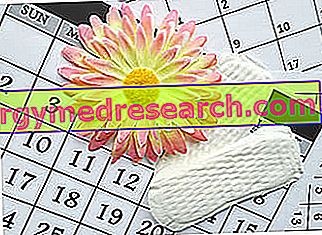Immediately after childbirth, vaginal blood loss is a completely normal phenomenon, just as small leaks in the following weeks are absolutely normal.

definitions
To better understand the phenomenon of post-partum losses, it is good to become familiar with some specialized terms:
- secondment : it is the natural phenomenon of detachment and expulsion of the placenta and all the fetal appendages, which normally occurs within 15-30 minutes from the birth; when anomalies arise in this phase we speak of pathologies of the secondary (for example, failure to detach the placenta and / or complete detachment without expulsion). In case of pathological conditions (often linked to problems of placenta previa or other placental anomalies) postpartum hemorrhage may be excessive; in this case the doctors could administer drugs intravenously or intramuscularly to help stop bleeding and / or to stimulate uterine contractions that allow the placenta to be expelled and facilitate hemorrhage arrest.
- postpartum pathologies : post-partum hemorrhages due to inadequate activation of the mechanisms of physiological hemostasis are grouped under this term; in these cases, the body of the pregnant woman cannot stop the loss of blood resulting from the detachment of the placenta.
- postpartum hemorrhage (EPP): doctors use this term when the loss of blood after childbirth is excessive, ie more than 500 ml in the case of vaginal delivery and 1000 ml in the case of cesarean delivery; postpartum hemorrhage is considered serious when it exceeds 1500ml, while above 2500ml it is called major blood loss;
- lochiazioni (or lochi) : loss of blood, mucus and cellular elements that typically accompany the first 3-6 weeks after birth (they tend to last longer in nursing women, and vice versa); this phenomenon is due to the wound left by the detachment of the placenta and to the gradual return of the uterus to the pre-pregnancy dimensions, with phenomena of cell digestion and expulsion of mucus, fluid residues and fetal membranes. In the first days after the birth, the lochiazioni have essentially blood characteristics, with traces of clots; therefore they appear dark red. Subsequently, the lochiazioni tend to take on a gradually clearer color to yellowish-white, and a creamy consistency.
The phenomenon of lochiazioni is closely linked to uterine contractions (called " uterine bites " in this phase), which will therefore continue to accompany the woman for a few weeks after giving birth. Generally these contractions become more intense and annoying from the second birth onwards; they are also favored by breastfeeding, thanks to the action of oxytocin, whose secretion is stimulated by sucking the baby.
- capoparto : it is the reappearance of the menstrual flow, or the first menstruation after the birth of the child. In general, if the woman has not breast-fed, the chief-officer appears within a very short time after the termination of the lochiazioni; vice versa, in the nurses the capoparto takes place after a longer period.
Tips
- Since the lochi represent a fertile ground for the development of bacteria, it is important to practice an adequate intimate hygiene of the external genitalia, washing them carefully with specific detergents at each change of absorbent; unless otherwise advised by a doctor, it is advisable to avoid the use of internal sanitary napkins, because they could favor the stagnation and proliferation of germs. Consider, in this regard, that the changes undergone by the uterus in the immediate post-partum phase also have the purpose of counteracting pathogens entered during childbirth, thanks to the massive infiltration of white furniture.
- If the lochiazioni give off a particularly unpleasant smell, if they take on a brownish-green color, if they are particularly abundant or if their color suddenly changes and become bright red, it is advisable to consult the gynecologist or the general practitioner immediately.
- Sexual intercourse is not recommended for the duration of the lochiazioni, or at least in the first phase, since it could facilitate the onset of infectious processes.



